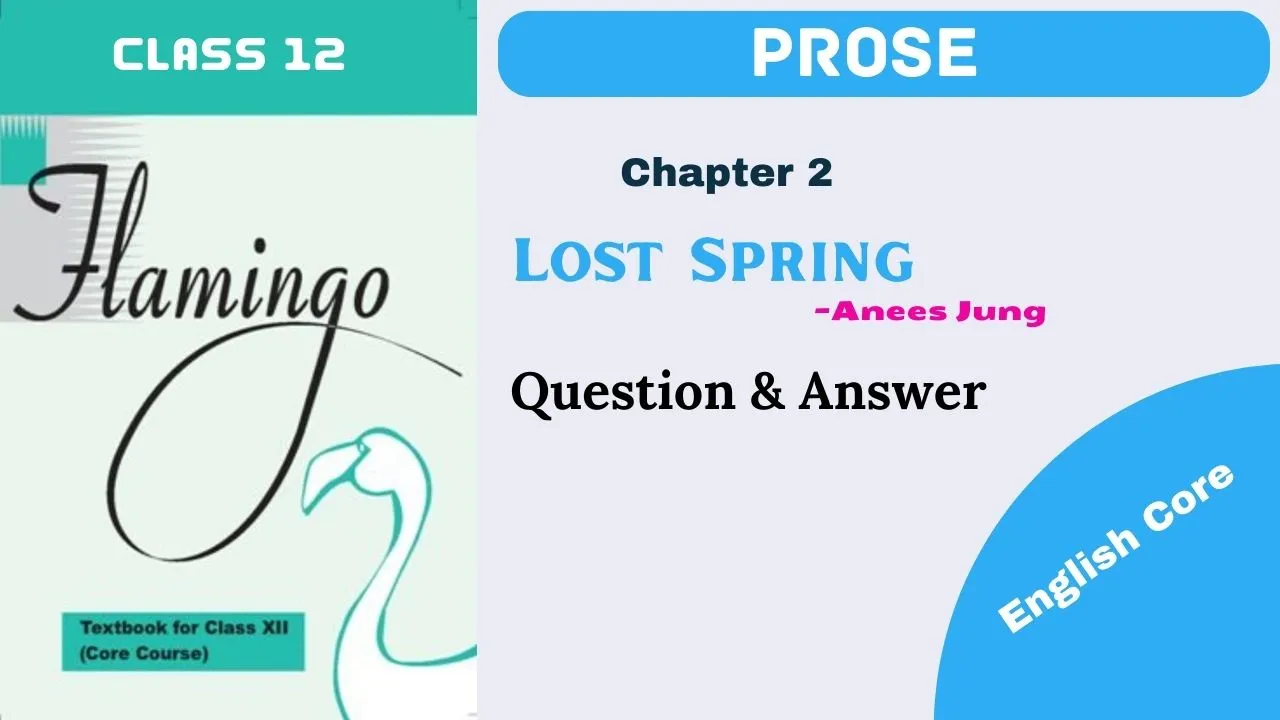Lost Spring Class 12 Questions Answers 2024 is a resource designed for the CBSE and NCERT curriculum for Class 12 students of 2024 from ‘Flamingo’, a Textbook in English for Class XII (Core Course)
It provides comprehensive questions and answers relating to Anees Jung’s story “Lost Spring.”
This Lost Spring Class 12 Questions Answers material is structured to aid students in understanding the summary and societal issues depicted in the story, aligning with the curriculum requirements set by CBSE and NCERT for Class 10 in 2024.
Summary of Lost Spring Class 12
“Lost Spring” by Anees Jung is a poignant narrative depicting the lives of impoverished children living in the streets of India. The story revolves around two main characters: Saheb, a ragpicker, and Mukesh, a boy working in the brassware industry.
Saheb, a deprived boy, collects scraps for a living, dreaming of the “lost spring” of his life – an unattainable fantasy symbolizing his childhood lost to poverty. Meanwhile, Mukesh, trapped in the brassware industry, works tirelessly due to his family’s socio-economic situation.
The story sheds light on the societal apathy towards these children, denied education and forced into labor due to their circumstances. It highlights the indifference of authorities and systemic barriers that perpetuate the cycle of poverty, limiting these children’s opportunities.
“Lost Spring” serves as a powerful commentary on the exploitation of children and the impact of poverty, urging readers to consider the plight of marginalized communities and the urgent need for societal change to break the chains of intergenerational poverty.
Translation
अनीस जंग की “लॉस्ट स्प्रिंग” भारत की सड़कों पर रहने वाले गरीब बच्चों के जीवन को दर्शाने वाली एक मार्मिक कहानी है। कहानी दो मुख्य पात्रों के इर्द-गिर्द घूमती है: साहेब, एक कचरा बीनने वाला, और मुकेश, पीतल के बर्तन उद्योग में काम करने वाला एक लड़का।
साहेब, एक वंचित लड़का, जीवनयापन के लिए कबाड़ इकट्ठा करता है, अपने जीवन के “खोए हुए वसंत” का सपना देखता है – एक अप्राप्य कल्पना जो गरीबी में खोए उसके बचपन का प्रतीक है। इस बीच, पीतल के बर्तन उद्योग में फंसे मुकेश अपने परिवार की सामाजिक-आर्थिक स्थिति के कारण अथक परिश्रम करते हैं।
यह कहानी इन बच्चों के प्रति सामाजिक उदासीनता, उनकी परिस्थितियों के कारण शिक्षा से वंचित और श्रम में मजबूर होने पर प्रकाश डालती है। यह अधिकारियों की उदासीनता और प्रणालीगत बाधाओं को उजागर करता है जो गरीबी के चक्र को कायम रखते हैं और इन बच्चों के अवसरों को सीमित करते हैं।
“लॉस्ट स्प्रिंग” बच्चों के शोषण और गरीबी के प्रभाव पर एक शक्तिशाली टिप्पणी के रूप में कार्य करता है, जो पाठकों से हाशिए पर रहने वाले समुदायों की दुर्दशा और अंतर-पीढ़ीगत गरीबी की जंजीरों को तोड़ने के लिए सामाजिक परिवर्तन की तत्काल आवश्यकता पर विचार करने का आग्रह करता है।
People also ask
Q3 Lost Spring Class 12 MCQ Questions Answers Extract Based 1
Read the following extract and choose the correct option.
A “I will learn to drive a car,” he answers, looking straight into my eyes. His dream looms like a mirage amidst the dust of streets that fill his town Firozabad, famous for its bangles. Every other family in Firozabad is engaged in making bangles. It is the centre of India’s glass-blowing industry where families have spent generations working around furnaces, wielding glass, making bangles for all the women in the land it seems.
Mukesh’s family is among them. None of them know that it is illegal for children like him to work in the glass furnaces with high temperatures, in dingy cells without air and light; that the law, if enforced, could get him and all those 20,000 children out of the hot furnaces where they slog their daylight hours, often losing the brightness of their eyes. Mukesh’s eyes beam as he volunteers to take me home, which he proudly says is being rebuilt.
i The simile ‘dream looms like a mirage amidst the dust of streets’ indicates that his dream was
a) a reality, yet seemed distant.
b) lost in the sea of dust.
c) illusory and indistinct.
d) hanging in the dusty air.
Ans: c) illusory and indistinct.
ii ‘I will learn to drive a car,’ he answers, looking straight into my eyes. This sentence highlights Mukesh was
1. determined
2. fearless
3. hopeful
4. valiant
5. ambitious
6. stern
a) 1 & 5
b) 2 & 4
c) 2 & 5
d) 3 & 6
Ans: a) 1 & 5
iii Which of the following statements is NOT TRUE with reference to the extract?
a) Children work in badly lit and poorly ventilated furnaces.
b) The children are unaware that it is forbidden by law to work in the furnaces.
c) Children toil in the furnaces for hours which affects their eyesight.
d) Firozabad has emerged as a nascent producer of bangles in the country.
Ans: d) Firozabad has emerged as a nascent producer of bangles in the country.
iv Every other family in Firozabad is engaged in making bangles indicates that
a) bangle making is the only industry that flourishes in Firozabad.
b) the entire population of Firozabad is involved in bangle making.
c) majority of the population in Firozabad is involved in bangle making.
d) bangle making is the most loved occupation in Firozabad.
Ans: c) majority of the population in Firozabad is involved in bangle making.
Q3 Lost Spring Class 12 MCQ Questions Answers Extract Based 2
Read the following extract and choose the correct option.
B. She still has bangles on her wrist, but no light in her eyes. “Ek waqt ser bhar khana bhi nahin khaya.” she says, in a voice drained of joy. She has not enjoyed even one full meal in her entire lifetime-that’s what she has reaped! Her husband, an old man with a flowing beard says, “I know nothing except bangles. All I have done is make a house for the family to live in.” Hearing him one wonders if he has achieved what many have failed in their lifetime. He has a roof over his head!
The cry of not having money to do anything except carry on the business of making bangles, not even enough to eat, rings in every home. The young men echo the lament of the elders. Little has moved with time, it seems in Firozabad, years of mind-numbing toil have killed all initiative and the ability to dream.
i ‘She still has bangles on her wrist, but no light in her eyes.’ This implies that
a) she is married but has lost the charm in her eyes.
b) she is a married woman who has lost her grace and beauty.
c) though she is married, her eyes are devoid of happiness.
d) she is a married woman who has lost her eyesight.
Ans: c) though she is married, her eyes are devoid of happiness.
a) pessimistic.
b) empathetic.
c) sympathetic.
d) optimistic.
Ans: d) optimistic.
iii Choose the term which best matches the statement ‘The young men echo the lament of their elders.’
a) acceptance
b) reflection
c) reiteration
d) doubtfulness
Ans: c) reiteration
iv ‘Years of mind-numbing toil have killed all initiative and the ability to dream’. This shows that
a) the bangle makers are exhausted yet they are enterprising and have dreams.
b) the drudgery of work has destroyed their willingness to improve their lot.
c) the daily grind has stolen the dreams of the bangle makers and made them dull.
d) the bangle makers have been working so hard that there’s no time to dream.
Ans: b) the drudgery of work has destroyed their willingness to improve their lot.
Q 5 Lost Spring Class 12 Stand Alone MCQs Questions Answers
i ‘But promises like mine abound in every corner of his bleak world’. This suggests that
a) there is no dearth of promises which remain unfulfilled.
b) there is a scarcity of people promising things for betterment.
c) people make a lot of promises which are often fulfilled.
d) promises made, live up to the expectations of people.
Ans: a) there is no dearth of promises which remain unfulfilled.
a) sympathy.
b) apathy.
c) empathy.
d) bewilderment.
Ans: a) sympathy.
iii ‘That’s why they left, looking for gold in the big city.’ Here ‘gold’ indicates
a) misfortune of circumstances.
b) ample wealth.
c) means of survival.
d) a sign of luxury.
Ans: c) means of survival.
iv Choose the statement that is NOT TRUE about ragpickers in Seemapuri.
a) Children are equally involved in rag picking as their parents.
b) The ragpickers settle down in a place permanently.
c) Rag picking has accomplished itself as a skill and form of art.
d) Ragpickers live in unsteady shanties on the outskirts of Delhi.
Ans: c) Rag picking has accomplished itself as a skill and form of art.
Q10 Lost Spring Class 12 Questions Answers in 30-40 words
i Why do you think Mukesh is content to dream of cars and doesn’t dream of flying a plane?
Ans: Mukesh might prefer dreaming of cars due to a personal fascination or comfort with automotive culture, associating freedom and success with cars. Flying a plane may not resonate similarly or align with his interests/passions, leading him to focus on automotive aspirations over aviation in his dreams.
ii Do you believe that ‘God-given lineage can be broken’? Support your position with a rationale.
Ans: “God-given lineage” is a belief in an unbroken ancestral line. However, lineage can evolve due to personal choices, cultural shifts, or adoptions, breaking the traditional bloodline. Life decisions, changes in belief systems, or societal influences can redefine lineage, indicating that while divine origins persist, the line can be altered by human agency.
Ans: The author, Anees Jung, likely experienced a heightened awareness of social disparities and the plight of impoverished children after her encounters detailed in “Lost Spring.” This might have inspired her to advocate for marginalized communities, prompting a deeper understanding of their struggles and potentially influencing her future writings and activism.
Q12 Lost Spring Class 12 Questions Answers in 120-150 words
i How does the story, ‘Lost Spring’ highlight the apathy of society and those in power to end the vicious cycle of poverty? Support your answer with textual evidence.
Ans: “Lost Spring” by Anees Jung portrays the cyclic nature of poverty and societal apathy through vivid narratives. The text illustrates the exploitation of children in the brassware industry, denied education and forced into labor. The authorities’ neglect is evident as they remain indifferent to the children’s plight. For instance, when the author inquires about their school enrollment, the response is bureaucratic apathy: “School? No, there is no school here.”
Furthermore, the system’s callousness is highlighted when the scrap dealer, Mukesh’s father, cannot obtain a license due to his social status. The narrator remarks, “It’s his poverty that stands in the way.” This systemic discrimination perpetuates poverty, hindering any upward mobility.
Jung’s portrayal underlines society’s disregard for these marginalized communities, perpetuating their exploitation. The lack of interventions and systemic barriers showcased in the story reflect the entrenched apathy of those in power, sustaining the vicious cycle of poverty by denying these children opportunities for advancement.
ii Certain traditions and lineage, condemn thousands of children to a life of abject poverty and choke their aspirations. • Do you agree? Explain. • How can we change this? Suggest some ways to tackle this issue.
Ans: I agree that certain traditions and rigid lineage systems can perpetuate intergenerational poverty, limiting children’s prospects and trapping them in dire circumstances. These traditions might restrict access to education, opportunities, or reinforce societal biases, hindering progress.
To address this issue, fostering education is paramount. Empowering children with quality education can break the cycle of poverty by providing knowledge and skills for better opportunities. Advocacy for gender equality, challenging societal norms that discriminate against certain groups, and promoting inclusive policies are crucial. Additionally, offering vocational training, mentorship programs, and financial assistance can uplift marginalized communities.
Cultural sensitization and community engagement play vital roles. Encouraging dialogue within communities to reevaluate harmful traditions while preserving valuable cultural aspects can help navigate change sensitively. Collaborative efforts involving governments, NGOs, and grassroots organizations are essential for implementing programs that prioritize equal opportunities, ensuring a more equitable future for these children.
Extra Lost Spring Class 12 Short Questions Answers 2024
What is Lost Spring about question answer?
Ans: “Lost Spring” is a story that portrays the lives of impoverished children in India, focusing on characters like Saheb and Mukesh. It highlights their struggles, societal neglect, and exploitation in labor. The narrative emphasizes the cycle of poverty and the need for societal change to improve the lives of these marginalized children.
Where does Saheb live now?
Ans: In “Lost Spring,” Saheb’s current residence or whereabouts aren’t explicitly mentioned. The story focuses on his life as a ragpicker in the streets of India, without specifying his present living situation or location beyond his occupation as a ragpicker.
Who is Mukesh in Lost Spring?
Ans: In “Lost Spring,” Mukesh is a young boy from the brassware-making community in India. He works in the industry due to his family’s poverty, symbolizing the plight of children trapped in labor due to societal and economic constraints.
What is the main point of Lost Spring?
Ans: The main point of “Lost Spring” is to shed light on the harsh realities faced by impoverished children in India, emphasizing the societal apathy, systemic barriers, and exploitative conditions that perpetuate the cycle of poverty and deprive them of a better future.
What are the two worlds in Lost Spring?
Ans: “Lost Spring” portrays the contrast between two worlds: one of poverty-stricken children like Saheb and Mukesh, living on the margins of society, and the other of privilege symbolized by the brassware industry, highlighting the stark disparities within Indian society.
What are the two worlds in Lost Spring?
Ans: In “Lost Spring,” the two worlds represent the stark contrast between the impoverished lives of children like Saheb and Mukesh, forced into labor and deprived of opportunities, juxtaposed with the affluent world of the brassware industry, showcasing societal disparities and inequalities.
What are the two most admirable qualities in Mukesh?
Ans: Mukesh from “Lost Spring” displays resilience by persisting through arduous work in the brassware industry despite his young age. Additionally, his determination to support his family, showcasing responsibility and devotion, stands out as commendable qualities.
What is the gender role in Mukesh family?
Ans: In Mukesh’s family portrayed in “Lost Spring,” traditional gender roles are observed where the women, including his mother and sister, engage in domestic duties like cooking and taking care of the household, while the men, like Mukesh’s father, often work outside the home.
What is Mukesh attitude towards life?
Ans: Mukesh in “Lost Spring” exhibits a determined and responsible attitude towards life. Despite facing poverty and hardships, he diligently works in the brassware industry to contribute to his family’s income, showcasing resilience and a strong sense of responsibility.
How in your opinion can Mukesh realize?
Ans: Mukesh’s realization could occur through education and access to opportunities beyond the brassware industry. Empowering him with schooling, vocational training, and exposure to diverse opportunities could broaden his horizons, offering a chance to break free from the cycle of poverty and pursue a more fulfilling life.
What makes Mukesh different from other boy of his age?
Ans: Mukesh differs from other boys of his age due to his early responsibilities and the necessity to work in the brassware industry to support his family. His maturity, diligence, and sense of duty set him apart from typical children his age who might have the luxury of a carefree childhood.
What are the similarities between Saheb and Mukesh?
Ans: Saheb and Mukesh from “Lost Spring” share similarities in their impoverished circumstances, being trapped in a life of labor at a young age due to their families’ financial struggles. Both boys face the harsh realities of poverty and societal neglect, impacting their childhoods.
Why did Saheb lose his carefree life?
Ans: Saheb lost his carefree life due to poverty and his family’s circumstances. Financial difficulties forced Saheb into becoming a ragpicker, depriving him of a carefree childhood and compelling him to work to support his family.
What positive values can you learn from the lives of Saheb and Mukesh?
Ans: From Saheb and Mukesh’s lives in “Lost Spring,” resilience, determination, and a strong sense of responsibility amid adversity stand out as positive values. Their ability to endure hardships and persist in supporting their families despite challenges offers lessons in perseverance and dedication.
How is Mukesh different from the other bangle Mukesh of Firozabad?
Ans: Mukesh from “Lost Spring” differs from the other bangle-making Mukesh of Firozabad as he represents a fictional character in a narrative depicting the struggles of impoverished children in India. This Mukesh is a symbolic figure highlighting the plight of children trapped in labor, distinct from an actual individual.
What does Mukesh grandmother say about her husband?
Ans: In “Lost Spring,” Mukesh’s grandmother fondly recalls her husband as a skilled artisan who crafted delicate glass bangles. She reminisces about his craftsmanship and dedication to his work, highlighting his expertise and the pride he took in creating beautiful bangles.
What does Mukesh grandmother say about their family profession?
Ans: In “Lost Spring,” Mukesh’s grandmother expresses a sense of loss regarding their family’s traditional profession of crafting glass bangles. She regrets that poverty compelled them to abandon their ancestral craft, emphasizing the sorrow of losing their artisanal legacy due to economic hardships.
What were the problems faced by the bangle sellers?
Ans: The bangle sellers faced various issues in “Lost Spring,” including economic challenges due to declining demand for their products, the lack of access to resources for sustaining their traditional craft, and the difficulty in competing with modern industries, leading to financial struggles and hardships.
Why is Mukesh dream a mirage?
Ans: Mukesh’s circumstances of poverty render his dream in “Lost Spring” a mirage as it portrays an unattainable aspiration.His dream of owning a set of car wheels remains elusive, symbolizing an unreachable goal due to the harsh reality of his economic limitations and societal constraints
Why is Mukesh different from Saheb?
Ans: Mukesh differs from Saheb in “Lost Spring” due to their respective occupations and family circumstances. While Mukesh works in the brassware industry due to his family’s economic struggles, Saheb is a ragpicker, symbolizing diverse experiences within the spectrum of child labor and poverty in India.
What is the irony in Saheb’s name?
Ans: The irony in Saheb’s name in “Lost Spring” lies in its meaning. “Saheb” typically denotes respect or authority, but Saheb’s reality contradicts this, as he lives in poverty and works as a ragpicker, devoid of the privileges or respect often associated with the name.
Who is more ambitious Mukesh or Saheb?
Ans: In “Lost Spring,” Mukesh appears to showcase more ambition than Saheb. Mukesh diligently works in the brassware industry, driven by responsibility to support his family. Saheb, while determined, faces a more precarious situation as a ragpicker, with fewer prospects to change his circumstances.
How is Mukesh attitude different?
Ans: Mukesh’s attitude in “Lost Spring” differs due to his strong sense of responsibility. Unlike many children his age, Mukesh displays maturity and determination, working diligently in the brassware industry to contribute to his family’s income, showcasing a remarkable level of responsibility and dedication.
What are the qualities of Mukesh?
Ans: Mukesh in “Lost Spring” exhibits qualities of resilience, responsibility, and determination. He showcases maturity beyond his years by diligently working in the brassware industry to support his family, highlighting his strong sense of duty and perseverance amid challenging circumstances.
Where does Mukesh live?
Ans: In “Lost Spring,” Mukesh lives in the brassware-making community of Seemapuri, located near Delhi, India. This impoverished settlement is where Mukesh resides with his family, struggling amidst challenging socio-economic conditions.
Who is Mukesh attitude?
Ans: Mukesh’s attitude in “Lost Spring” is characterized by determination, responsibility, and a strong work ethic. Despite his young age, he demonstrates a mature sense of duty and perseverance, working diligently in the brassware industry to contribute to his family’s income.
What is Mukesh ambition?
Ans: In “Lost Spring,” Mukesh’s ambition revolves around alleviating his family’s financial struggles. His primary goal is to work earnestly in the brassware industry to contribute to his family’s income and support them through their challenging socio-economic circumstances.
What does Mukesh want?
Ans: In “Lost Spring,” Mukesh desires to alleviate his family’s financial hardships. His primary aim is to work diligently in the brassware industry to provide for his family and contribute to improving their challenging socio-economic situation.
What does Mukesh want to learn?
Ans: In “Lost Spring,” Mukesh doesn’t explicitly express a desire to learn something specific. His primary focus is on working in the brassware industry to support his family, and there’s no clear mention of him expressing a specific interest in learning a particular skill or subject beyond his current responsibilities.
What is Mukesh’s dream?
Ans: In “Lost Spring,” Mukesh dreams of owning a set of wheels from a discarded automobile, symbolizing his aspiration for a better life and a future beyond poverty. This dream represents Mukesh’s yearning for something beyond his current circumstances, a symbol of hope amidst hardship.
Why was Mukesh eager to answer?
Ans: In “Lost Spring,” Mukesh’s eagerness to answer stems from his longing for interaction and a break from the monotony of his work in the brassware industry. He sees the chance to respond as a momentary escape from his routine, offering a brief respite from his laborious tasks.
Why is Mukesh Realise about his dream?
Ans: Mukesh realizes that his dream of owning car wheels is unrealistic given his impoverished circumstances. He becomes aware that achieving this dream is unattainable due to the harsh reality of his family’s financial struggles, leading to a sense of resignation about the feasibility of his aspirations.
What is Mukesh dream for his future?
Ans: In “Lost Spring,” Mukesh’s dream for his future is not explicitly detailed. However, his overarching aspiration seems to revolve around improving his family’s financial situation and breaking free from the cycle of poverty, seeking a better life beyond the challenging circumstances he faces.
What is Mukesh content to dream of?
Ans: In “Lost Spring,” Mukesh is content to dream of owning a set of wheels from a discarded automobile. This dream represents his yearning for a better life, symbolizing hope and aspirations for a future beyond the constraints of poverty and hardship.
How is Mukesh attitude different from that of his family?
Ans: In “Lost Spring,” Mukesh’s attitude differs from his family’s as he displays a strong sense of responsibility and determination towards work. Unlike his family, who might be more resigned to their circumstances, Mukesh shows a proactive approach, taking on the burden of supporting his family at a young age.
What is Lost Spring about question answer?
Ans: “Lost Spring” narrates the plight of impoverished children like Saheb and Mukesh in India. It depicts their struggles, societal neglect, and exploitation in labor. The story highlights the cycle of poverty and the challenges faced by these children, emphasizing the need for societal change.
What is the main point of Lost Spring?
Ans: The main point of “Lost Spring” revolves around the harsh realities of impoverished children in India, showcasing the cycle of poverty, societal indifference, and the struggle for survival amidst economic and social challenges, urging for awareness and societal changes to alleviate their plight.
Where does Saheb live now?
Ans: In “Lost Spring,” the narrative does not explicitly mention Saheb’s current residence. The story primarily focuses on his life as a ragpicker in the streets of India. There isn’t a specific mention of his current living situation or location beyond his occupation as a ragpicker.
Who is Mukesh in Lost Spring?
Ans: In “Lost Spring,” Mukesh is a young boy living in Seemapuri, India. He works in the brassware industry due to his family’s impoverished circumstances, embodying the struggles of children forced into labor to support their families amidst challenging socio-economic conditions.







